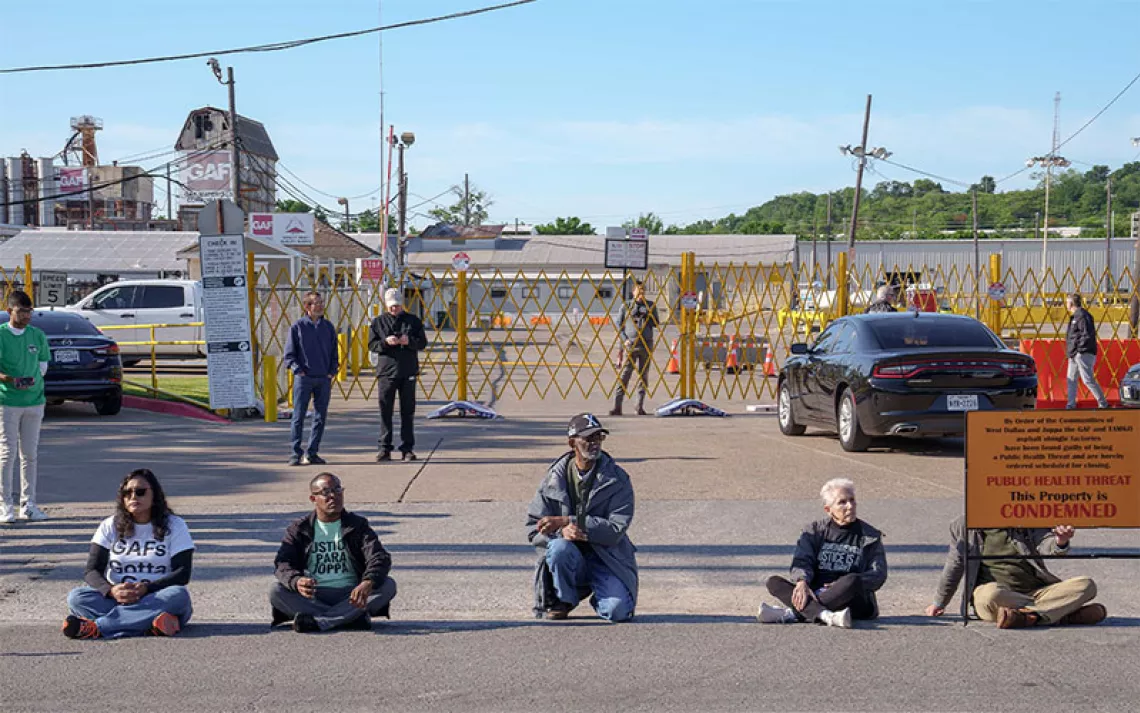Ukraine Is Ground Zero for the Environmental Impacts of War
The heavy cost will be borne by generations to come

Russian military trucks destroyed during fighting between Russian and Ukrainian forces on April 1, 2022. | Photo by Vadim Ghirda/AP Photo
On Tuesday, April 5, the governor of Luhansk Oblast in eastern Ukraine posted a photograph of an orange plume of smoke on Telegram. It was the result of a Russian strike on a nitric-acid-filled tank.
Nitric acid is used to produce ammonium nitrate, a major component of fertilizers. It is also used for producing explosives like nitroglycerin and trinitrotoluene (TNT). This highly corrosive mineral acid plume prompted a warning from Governor Serhiy Haidai, who advised Rubizhne city residents to stay inside, close their windows and doors, and wear masks because of the risk of serious injuries if inhaled. When in contact with flesh, nitric acid will cause severe chemical burns, quickly.
Haidai also stated that after it rained, the nitric acid would be diluted and no longer pose a danger. But questions remain as to the volume of nitric acid in the container and how much of the chemical will be absorbed by the surrounding soil, plants, trees, and groundwater, and the cascading effects on wildlife. The manufacture of nitric acid releases nitrous oxide, a greenhouse gas that depletes ozone and is 265 times more harmful to the climate than carbon dioxide, into the atmosphere.
In addition to the humanitarian crisis, this is just one attack, one environmental impact, on one day of the Ukraine War.
On the same day, 523 miles to the northwest in Chernobyl, Ukraine officials informed the International Atomic Energy Agency (IAEA) that the country started resuming regulatory control at the Chernobyl Nuclear Power Plant. Russian troops took over the facility in late February at the start of the invasion but withdrew to Belarus on Thursday, March 31. The IAEA has not been able to confirm reports of Russian forces receiving high doses of radiation while being in the Chernobyl Exclusion Zone. Ukraine’s defense ministry tweeted, “Russian occupiers left Chernobyl nuclear power plant. Two key reasons: losses caused by [Ukraine] army and radiation exposure.”
There have been other tweets to support this claim of Russian troops digging trenches, including video from a drone flying over the Chernobyl exclusion zone.
If the IAEA confirms that Russian soldiers were exposed while digging in and fortifying their positions in Chernobyl, they could have suffered from Acute Radiation Syndrome, an acute illness caused by irradiation of the entire body—or most of the body—by a high dose of penetrating radiation in a very short period, usually a matter of minutes. According to the CDC, the three main areas affected are bone marrow, gastrointestinal or GI, and cardiovascular/central nervous system.
Rubizhne’s nitric-acid tank strike and Chernobyl are just a snapshot of the environmental impacts of Russia’s war on Ukraine. While the world should rightfully focus on the humanitarian catastrophe this war has caused, its ecological consequences are part of that story—and research shows the Ukrainian people will bear the cost.
Scholars and experts have comparable data from the global “War on Terror.” The Cost of War Project, housed at Brown University’s Watson Institute and Boston University’s Pardee Center, was launched to document the unacknowledged costs of the post-9/11 wars in Afghanistan, Iraq, and elsewhere. The cost analysis is parsed into three categories: budgetary, human, and environmental. In evaluating the environmental cost, the authors conclude, “The US produced 1.2 billion metric tons of GHGs since the beginning of the [Global War on Terror] in 2001. More than 400 million metric tons are directly due to war-related fuel consumption.” Note that 1.2 billion metric tons of GHGs is equivalent to the annual emissions of 257 million passenger cars, which is more than double the current number of cars currently on the road in the United States.
Armed conflict in cities not only displaces, kills, or gravely wounds civilians, the infrastructure necessary for the functioning of basic services is damaged or destroyed. Damage to wastewater and drinking water may lead to contamination of water resources. Explosions from rockets or fires generate huge volumes of debris and waste. The release of hazardous materials such as asbestos, industrial chemicals, and fuels compound the effects of environmental contamination.
And there will be lasting damage to Ukrainian land from unexploded ordinance, or UXO. An explosive device that fails to detonate or partially detonates can deposit toxic explosive materials into the surrounding soil and waters, according to the Small Wars Journal.
Meanwhile, the effort to supply Ukraine with arms and equipment bears its own cost. More than 25 nations have sent billions of dollars in missiles, ammunition, and other items. The transport of military material is a herculean effort, which requires jet fuel. According to the US Energy Information Administration, jet fuel produces an average of 21.1 pounds of CO2 per gallon and aviation gas 18.4, while fuel for cars is 19.6 pounds. None of these figures include emissions from explosions, fires, ammunition spent, destruction of vehicles, and property. Neither do these figures include the rebuilding process. Consider the fact that manufacturing cement produces about 0.9 pounds of CO2 for every pound of cement.
In February, Flagstok, an independent Belarusian media outlet, found that an abandoned airbase outside of the city of Homyel served as a staging area for Russian equipment and troops. The Russians have also been reported to have units coalescing far away from bases that are closer to the border with Ukraine. Satellite images showed that Russian troops were 25 to 30 miles away from Ukraine’s Chernihiv region, which is 125 miles from Kyiv.
Russian convoys fleeing Chernobyl to Belarus would burn through petrol. Those emissions would coat the Pinsk Marshes—an area of wetlands roughly 100,000 square miles in size. Wetlands play a vital role in carbon storage. Although they are capable of absorbing pollutants from surface water, there is a limit to their capacity to do so.
If the war continues through summer with Russian shelling, a wildfire in drought-stricken Ukraine will also have cascading effects. Suppressing a wildfire during the hottest months of the year while trying to repel an opposing force with limited resources will compound the damage.
War making, and the industry of war, have long-standing consequences on the environment and public health. As Russia continues to employ a strategy of bombarding cities into submission, the heavy cost will be borne by generations of Ukrainians to come.
 The Magazine of The Sierra Club
The Magazine of The Sierra Club



